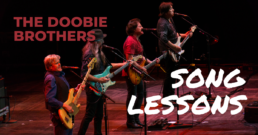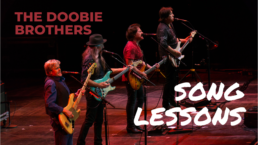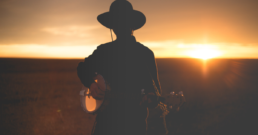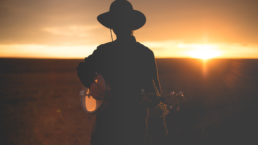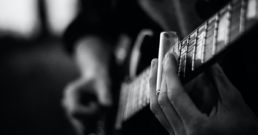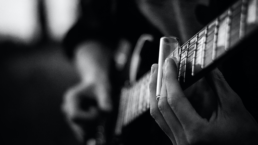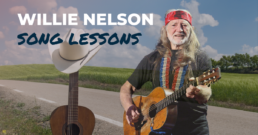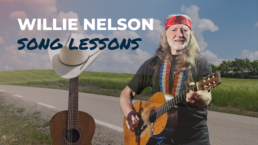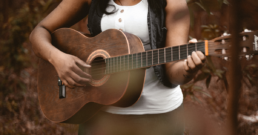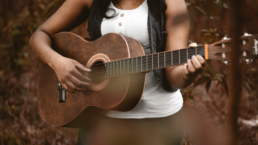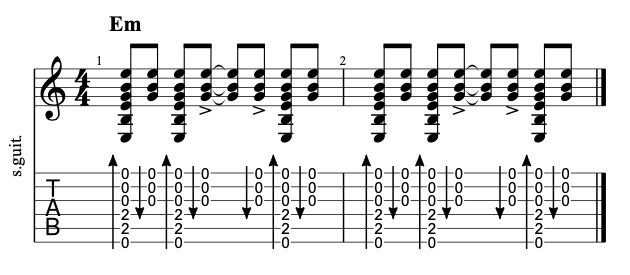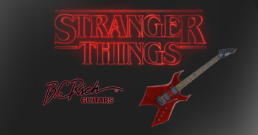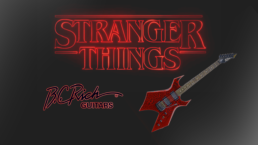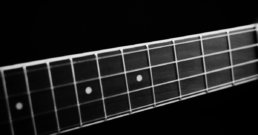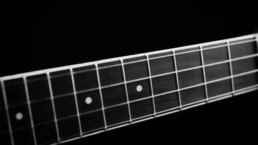What Makes a Guitar Solo Great?
What Makes a Guitar Solo Great?
Every guitar fan loves a great guitar solo.
If you’re a confident lead player, the guitar solo is the part of the song where you get to strut your stuff. In the heyday of classic rock in the 70s and 80s, guitar solos were almost obligatory, Players like Eddie Van Halen, Randy Rhoads, Yngwie Malmsteen, and Steve Vai pushed the boundaries of what was expected and even possible.

Rock music split in the 1990s with the advent of grunge. Pyrotechnics gave way to riffs and down-tuned muscle as virtuosity went out of fashion. Some of the best guitar playing on the radio in the mid-90s was not in pop or rock music at all, as hot Nashville pickers like Brent Mason ripped out more notes in a country solo on a clean Telecaster than 10 minutes of modern rock radio.
Another approach had also been brewing all along. There was no room for guitar solos in the punk movement of the 70s, which was in some ways as a reaction to their prevalence in rock. But as punk diversified into new wave, guitarist like U2’s The Edge and The Police’s Andy Summers started carving out a more textural sound, influencing players from Rush’s Alex Lifeson to Radiohead’s Johnny Greenwood. Johnny Marr, Peter Buck and James Honeyman-Scott brought aggressive jangle with The Smiths, REM and The Pretenders.
These stylistic extremes might seem to have little to do with each other. But every guitarist’s first responsibility is to serve the song. In the best bands, the musicians serve the song with a personal style and sound, and these are often the players with the most impact.
The best guitar solos are memorable in themselves because they accomplish all of those things. The number of notes is not what makes the impact, or necessarily even the notes themselves.

It’s the intersection of energy, tone, dynamics, melody, and phrasing, and how those things taken together create a powerful statement.
A solo can have lots of notes and still have all these qualities. The point isn’t whether or not the solo is virtuosic. Virtuosity is an option if you have the chops, and sometimes the only natural choice. But regardless, the solo should feel like an integral and essential part of the song. Dynamically, it creates an energetic build that carries the listener to the song’s climax. Sometimes melody isn’t even the point but sheer power, or open space, or glorious noise.
This is what you listen to first: what the song wants, and what you can do to contribute to it. Think of your soloing as songwriting – after all, improvisation is spontaneous composition. Strive above all to be memorable, whether you use a few notes to do it or sheets of sound.
If you want to learn more about melody and phrasing, there are numerous courses on JamPlay on the subject. This is a great place to start!
Interested in learning to solo on guitar? Check out JamPlay.com. JamPlay has over 450 guitar courses from 120+ instructors, and online guitar lessons tailored to every skill level, music genre, and playing style. Click here to learn more.
Dave Isaacs has established himself as a guitar teacher extraordinaire, having built a strong set of educational curriculums for beginner, intermediate, and advanced guitar players alike. Dave shares his expertise largely through video platforms, but also through his thoughtful writing. You can take guitar lessons from Dave Isaacs via his comprehensive video guitar courses on JamPlay.com.
Share this
Become a JamPlay member for unlimited access to 7000+ guitar lessons and 120+ artists and instructors. View membership plans ›
Related Posts
The Doobie Brothers Song Lesson Playlist
Today, “Classic Rock” is a name we use to refer to album-oriented rock that graced the 1960s and 1970s, as well as to hard rock that emerged in the ’80s and ’90s. If you were to designate one band as the poster child of this this title, however, you wouldn’t be wrong for picking The Doobie Brothers.
This GRAMMY winning, Rock-and-Roll-Hall-of-Fame-inducted band has existed in two distinct forms since their 1970 inception, and spanned several sub-genres. The first “form” of the band featured Tom Johnston on lead vocals, and was far more rock-infused. During this period, the band produced super hits such as, “Listen to The Music,” “Long Train Runnin’,” “Black Water,” and “China Grove.” After suffering from health issues that prevented him from performing, Johnston stepped down as The Doobie Brothers’ frontman in 1976. In order to uphold a record contract for a new album, the band summoned keyboardist and singer, Michael McDonald to front the group and write new material. This began The Doobie Brothers’ second phase that was markedly more in vein of (the genre known as) “blue-eyed soul.” It was during this period the band released even more charting hits, such as “What a Fool Believes” and “Takin’ It To The Streets.”
In this blog, we’ll be highlighting JamPlay’s collection of comprehensive, studio-accurate guitar song lessons. If you’re a Doobie Brothers fan, there’s no better way to learn their songs than the way they were recorded. Let’s dive right in!
“Black Water” by The Doobie Brothers – Song Lesson – JamPlay
Legend has it that “Black Water” was the brain child of Patrick Simmons, as he was encouraged to write the song after playing the opening riff for his producers in the studio. The song was recorded in 1973, and by mid-1975 it became The Doobie Brothers’ first No. 1 hit.
“Black Water” features a Delta-blues-esque acoustic guitar riff that sets the song’s tone. This is accompanied by other acoustic guitar parts throughout.
In JamPlay educator, Tyler Grant’s song lesson, you’ll learn all of the guitar parts for “Black Water.” Check out the full, comprehensive Doobie Brothers song lesson here!
“China Grove” by The Doobie Brothers – Song Lesson – JamPlay
From their 1973 album, The Captain and Me, “China Grove” is a rock-heavy jam that lingered in the Top 40 for eight weeks upon its release. When Tom Johnston wrote the song, he believed he had invented a fictional place called “China Grove.” Supposedly, he later learned from a cab driver that there is, in fact, a real city in Texas called China Grove.
The song focuses mainly on a “cascade” of rhythm guitar parts. The power chord riffs that introduce the song’s theme truly lay the foundation for the whole tune. Chris Buono shows you how to play these parts in his comprehensive, “China Grove” Doobie Brothers guitar lesson. Learn more about the full lesson here!
“Listen to the Music” by The Doobie Brothers – Song Lesson – JamPlay
Released in 1972, The Doobie Brothers’ mega hit, “Listen to the Music” is a force to be reckoned with. Though it only peaked at No. 11 on the US charts, it was covered by both Sonny & Cher and The Isley Brothers the following year. This song remains a popular track on classic rock radio nationwide, and is The Doobie Brothers’ current top song on Spotify.
In his full JamPlay song lesson, David Isaacs shows you how to play all of the parts of “Listen to the Music.” Check out the lesson here!
“Long Train Runnin'” by The Doobie Brothers – Song Lesson – JamPlay
Also from The Captain and Me, “Long Train Runnin’” started as a live-only jam that Tom Johnston apparently didn’t even want to record! But we’re glad he did. This song peaked at No. 8 on the US charts, and was covered by other notable acts, such as Bananarama. “Long Train Runnin'” was also remixed in 1993 to fit modern listening formats, and the re-release charted in many countries worldwide.
This song features two guitar parts that lay out a rhythmic and harmonic landscape for most of the song. D.J. Phillips shows you how to play both guitar parts as heard on the recording in his full “Long Train Runnin'” song lesson!
For more Song Lessons, check out JamPlay.com! JamPlay has over 450 guitar courses from 120+ instructors, and online guitar lessons tailored to every skill level, music genre, and playing style. Click here to learn more.
Share this
Become a JamPlay member for unlimited access to 7000+ guitar lessons and 120+ artists and instructors. View membership plans ›
Related Posts
September 15, 2022
Happy International Country Music Day!
Happy International Country Music Day!
Did you know September 17th is International Country Music Day? Well, now you do!
Country music, as a genre, is the metaphorical progeny of blues, jazz, and Appalachian Folk music. Supposedly, this southern style started gaining more national attention in the 1920s, but was still considered “hillbilly” music. But, by the 1940s, Country music was all the rage, as it began to appear in Hollywood feature films. And the rest is history! Since then, many sub-genres of Country have emerged, including Rockabilly, Western Swing, the “Nashville Sound,” Honky Tonk, and most recently, Country Pop (and many, many more)! JamPlay is celebrating the whole Country music family tree this weekend. Here are 3 free Country guitar lessons so you can celebrate with us!
BEGINNER – Country Solo Guitar Lesson with Lance Ruby
In this lesson, JamPlay educator, Lancy Ruby demonstrates how to play a relatively simple Country guitar solo. The solo is roughly in the style of Johnny Cash‘s guitarist, Luther Perkins, who is a founding father of Country music sub-genre, Rockabilly. Some skills you’ll get to practice while learning this solo are string bending, playing chromatic melodies, and playing double stops.
For the full lesson, check out Lance Ruby’s beginner Country guitar course on JamPlay!
INTERMEDIATE – Merle Travis Style Picking (“Travis Picking”) Guitar Lesson with Jim Deeming
In this lesson with Jim Deeming, you’ll get familiar with one of Western Country music’s most prominent styles: “Travis Picking“. This fingerstyle technique was made famous by Merle Travis during the ’40s, ’50s, and ’60s. Because the technique itself requires a bit more dexterity in your right hand, this lesson is great for any player looking to expand their intermediate guitar skills!
For the full lesson, check out Jim Deeming’s full course on JamPlay!
ADVANCED – Country Arpeggio Study Guitar Lesson with Andy Wood
For those of you who consider yourselves an “advanced” guitar player, this lesson is for you. Here, Andy Wood shows you some of his approaches to soloing over a standard blues form (which is common in Country music). The focus of the lesson is arpeggiating chords, which means playing melodies that outline the notes comprising each chord. Remember to start slow, and reduce the playback speed of the video if you need to.
For the full lesson with guitar tab, check out Andy Wood’s full JamPlay guitar course!
Excited to look learn how to play Country guitar? Check out JamPlay.com! JamPlay has over 450 guitar courses from 120+ instructors, and online guitar lessons tailored to every skill level, music genre, and playing style. Click here to learn more.
Share this
Become a JamPlay member for unlimited access to 7000+ guitar lessons and 120+ artists and instructors. View membership plans ›
Related Posts
The Different Types of Guitar Slides Explained
The Different Types of Guitar Slides Explained
Whether you are into blues or country music, you’ve probably seen or heard someone using a guitar slide at some point. We can trace the slide technique back to some African traditions, as well as the American diddley bow (a stringed instrument that you play with a glass bottle slide). The Hawaiian nation can also be credited as the birthplace of “steel” slide guitar. The former is the predecessor for blues slide guitar, and the latter would later play a prominent role in country music. Of course, there are other applications of slide guitar, but these are the main genres where we hear it the most.
But… did you know guitar slides made from different materials are used for different purposes? Or that the dimensions of the slide affect the tone and playability of a slide? We’re here to talk about the different types of guitar slides and what they are used for. Let’s slide!

1. Glass Slides
Glass guitar slides are probably the most popular item on this brief list. Today, glass slides are typically made from either tempered glass or pyrex. But in the early days, guitarists would use glass medicine bottles, wine bottle necks, or sometimes even whole beer bottles!
If you are chasing a warmer tone that presents more of your guitar’s midrange, this slide is for you. Glass is also a perfect material to glide easily up and down the strings; you’ll experience the least amount of friction. Glass slides, especially ones that are thicker, are a great choice for playing acoustic guitars. Be aware, however, that glass typically provides you with relatively short sustain. So if you want something that will help you carry out long notes, you may want to try the next option on this list!
But if this is what you’re looking for, Dunlop, amongst others, makes terrific glass guitar slides you can find on Sweetwater!

2. Metal Slides
Using metal guitar slides was effectively popularized by Hawaiian musicians, and they originally used solid steel bars. This is still, typically, how lap steel or pedal steel music is played. But metal slides have been improvised many different ways over the years. There are even accounts of blues musicians using knives and cigarette lighters as slides!
As mentioned in the glass slide portion, metal slides are generally better for sustaining notes, as they are usually heavier. Metal guitar slides will also produce a much brighter tone. In their hollow form, these tend to be the slides of choice for blues soloists. This also applies to blues artists playing on resonator guitars.
If this type of slide suits your fancy, check out the selection of them on Sweetwater!

3. Ceramic Slides
The youngest invention on this list of guitar slides is the ceramic slide. So there isn’t a whole lot of history to talk about… yet! These fragile tools serve as a functional middle point between glass and metal slides. They are more bright than glass, yet retain some warmth. And they sustain more like metal, though not quite as well. So, if you aren’t totally sure what your style is yet, a ceramic guitar slide might be the perfect way to find that out!
The slide pictured here is a Rev. Willy’s model from Dunlop, which you can find on Sweetwater!
Interested in learning to play slide guitar? Check out JamPlay.com! JamPlay has over 450 guitar courses from 120+ instructors, and online guitar lessons tailored to every skill level, music genre, and playing style. Click here to learn more.
Share this
Become a JamPlay member for unlimited access to 7000+ guitar lessons and 120+ artists and instructors. View membership plans ›
Related Posts
Willie Nelson Song Lesson Playlist
If you’ve ever been a fan of country music (or have read any headlines about marijuana legalization in the last 30 years) you’ve probably heard of the legendary, Willie Nelson. Willie, born during the Great Depression, has made a name for himself as one of history’s greatest country songwriters over his ongoing 60+ year career. He is also one of the most prominent icons of the sub-genre, “outlaw country.” Having released critically acclaimed albums such as Shotgun Willie, Red Headed Stranger, and Stardust, Willie Nelson has become the recipient of multiple musical honors, including ten GRAMMY Awards, twelve CMA Awards, and eight American Music Awards.
Of course, no musician receives such high praise without releasing some great songs! In this article, we’ll be showcasing the Willie Nelson song lessons that you can learn on guitar right here at JamPlay! Let’s take a look at our first song.
“On The Road Again” – Willie Nelson
It would be impossible to showcase Willie Nelson’s best work without mentioning his 1980 hit, “On The Road Again.” Nelson wrote the song as the theme for the feature-length film, Honeysuckle Rose. This was the first film in which Nelson starred as the lead role. The song itself went on to peak at number one on Billboard’s US Hot Country Songs, win Best Country Song at the 53rd GRAMMY Awards, and become inducted into the GRAMMY Hall of Fame.
In JamPlay educator, D.J. Phillips‘ song lesson, you’ll learn all of the guitar parts for “On The Road Again.” Check out the full, comprehensive Willie Nelson song lesson here!
“Funny How Time Slips Away” – Willie Nelson
Willie Nelson’s song, “Funny How Time Slips Away” was not originally recorded by Nelson, himself. Before he debuted as a performing artist, Nelson was hired as a behind-the-scenes writer for other artist. This 1961 hit was written for country artist, Billy Walker. Then a year later, Willie Nelson released his own version that appeared on his first solo studio album, …And Then I Wrote.
The song features two distinct guitar parts; one on an acoustic guitar and the other on an electric guitar. D.J. Phillips shows you how to play both of these parts in his comprehensive, “Funny How Time Slips Away” Willie Nelson song lesson. Learn more about the full lesson here!
“Crazy” – Willie Nelson
Another perfect example of Willie Nelson writing a hit for another artist is his song, “Crazy.” This 1961 country ballad was written for Patsy Cline, and became her most recognizable, popular single ever. In fact, her version of the song became so successful in 1961, she was named Billboard’s Favorite Female Country artist that year. Then, of course, Nelson re-recorded the song and released it on his debut album the following year.
This song also features two guitar parts that mainly provide a rhythmic and harmonic landscape under the song’s lyrics and melodies. D.J. Phillips shows you how to play both guitar parts as heard on the recording in his full “Crazy” song lesson!
For more Song Lessons, check out JamPlay.com! JamPlay has over 450 guitar courses from 120+ instructors, and online guitar lessons tailored to every skill level, music genre, and playing style. Click here to learn more.
Share this
Become a JamPlay member for unlimited access to 7000+ guitar lessons and 120+ artists and instructors. View membership plans ›
Related Posts
September 8, 2022
3 Famous Country Guitar Riffs You Should Know
3 Famous Country Guitar Riffs You Should Know
It’s September 2022 and we, at JamPlay, are putting a special emphasis on learning country music. One of the most fun ways to start learning country guitar is to focus on the most recognizable melodies, rhythms, and chord progressions from the songs we love. This is why learning guitar riffs can feel so rewarding!
In this blog, we’ll be taking a look at songs from three famous country music artists, and the famous riffs that accompany them. Saddle up, and let’s ride!
1. “El Paso” by Marty Robbins – Country Guitar Riff

Marty Robbins‘ 1959 hit, “El Paso” is a true ode to the Wild West. The song’s lyrics are from the perspective of a cowboy in El Paso, Texas. The young man finds love, faces betrayal, challenges his foes to gunfights, and rides away on a stolen horse. It doesn’t get too much more “Wild West” than that! The song as a whole was critically acclaimed; just two years after its release, it won the GRAMMY Award for Best Country & Western Recording.
There’s no doubt that the arrangement of this song aided in its widespread success. One of the most recognizable features of its arrangement, amongst many others, is a steel string acoustic country guitar riff that masterfully compliments Marty Robbins’ wistful vocal melodies. In Tyler Grant’s full JamPlay song lesson, you’ll learn how to play all of the guitar parts on “El Paso” exactly how you hear them on the record. What are you waiting for? Check out this country guitar lesson!
2. “It’s Time You Learned About Good-bye” by Alan Jackson – Country Guitar Riff

Though it may not be as popular as “It’s Five ‘O Clock Somewhere,” Alan Jackson’s “It’s Time You Learned About Good-bye” is the perfect vessel for some good ‘ole country guitar lead playing. Lyrically, the song follows a male protagonist whose love interest has been fair-weather at best. The protagonist expresses his disembarking from the relationship, and thus his former lover must “learn about good-bye.”
Compositionally, the lead electric guitar parts return to similar melodic themes throughout the song, but none of the lines are technically the same. So, it may be more fair to classify these lead guitar parts as licks and solos. However, they do occupy space into which a catchy riff could easily be worked. JamPlay educator, David Wallimann gives us a demo and an overview of the song in this video. But, you can learn all of the guitar parts verbatim (including the guitar solo) in his full “It’s Time You Learned About Good-bye” song lesson.
3. “Mama Tried” by Merle Haggard – Country Guitar Riff

Merle Haggard is one of country music’s all-time best contributors. He boasted 38 number-one hits between 1960 and 1980, and was awarded some of the highest musical honors one can receive (a GRAMMY Award being amongst them). His 1968 song, “Mama Tried” was amongst his greatest hits, peaking at number one on the US country music charts. This song was also awarded the Grammy Hall of Fame Award in 1999, and has been professionally covered by dozens of other popular artists. The song tells the tale of the widowed mother of the song’s protagonist. Despite the protagonist’s mother’s efforts to raise him “right,” he ultimately ends up turning to a life of crime and becoming incarcerated. These lyrics are supposedly loosely based on Merle’s own experience; he had a troubled childhood following his father’s death and spent some time in prison as an adult.
Compositionally, this track features a couple guitar riffs that are essential to the song’s recognizability. An acoustic guitar arpeggiates the song’s chord progression, while an electric guitar wails the song’s main riff. In his full “Mama Tried” country guitar lesson, D.J. Phillips breaks down all of the important guitar parts in this song. Check it out here!
Want to learn more songs on guitar? Check out JamPlay.com! JamPlay has over 450 guitar courses from 120+ instructors, and online guitar lessons tailored to every skill level, music genre, and playing style. Click here to learn more.
Share this
Become a JamPlay member for unlimited access to 7000+ guitar lessons and 120+ artists and instructors. View membership plans ›
Related Posts
Better Strumming: Don't Count, Feel
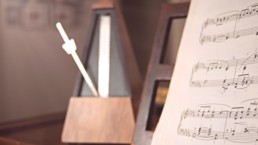
Strumming is a topic that doesn’t get nearly enough attention, given how many people struggle with it. Seems simple enough: swing the arm and hit the strings. But if you find it challenging to keep time and stay smooth, you already know there’s more to think about. It starts with feeling the pulse.
Let’s define “pulse” as a steady beat. Songs have a meter, which groups the pulses into twos and threes (and more). Playing in time really requires an awareness of three things at once: the steady pulse, the cycle of the meter, AND the actual beat of the song.
Keeping steady time isn’t hard. If you can walk (or breathe), your body knows what an even pace feels like.
There’s a physical feeling, a pulse, in the cadence of your steps. If you concentrate on it for a moment, you might notice that the sensation of your foot hitting the floor marks the beat exactly as a drum might.
Now moving that sensation to your hands, tap out four even beats with your dominant hand. Again, observe the feeling of arrival on the beat, and the sound that it creates. Then try alternating hands, leading first with the dominant hand and then the other. You’ve just established a basic 4/4 pulse as it’s often expressed in popular music. Tap with your foot on the downbeat and your hand on the second beat. This is a basic drum groove: thump, snap, thump, snap – usually expressed as kick, snare, kick, snare.
That back-and-forth creates a sense of forward motion that wasn’t there when we tapped even beats. Each beat is an arrival, but now we’re responding to the alternation of two different sounds. If the foot-hand move is tricky to coordinate at first, work with it slowly. It’s important to establish the difference in feel between the 1 and the 2, the foot and the answering hand.
Strumming alternates too, of course, as the arm moves up or down. But that takes us out of the larger context.
Instead of just pumping the arm, feel the downbeat as an arrival and the upstroke as a return to the starting point.
Here’s a simple back-and-forth eighth-note rhythm, indicated the way one often sees on internet chord charts:
D u D u D u D u
Of course, this format has obvious flaws in that it doesn’t indicate the timing, only the direction. Here, our timing is steady so things line up. But this is a much clearer way to express it:
Hold an E minor chord and play the pattern. Think of walking and the sensation of feet hitting the floor. If tapping your foot feels good, do it. If that’s tricky to coordinate, try nodding your head. It doesn’t matter how, but you want to feel that steady pulse with your body. Stay aware of the difference in sound, dynamic, and feel between a down and an up stroke.
Now strumming the pattern again, feel the rhythm in your fingertips, coming from the sensation and of the pick or finger striking the string. Just like your foot hitting the floor, there’s a moment of contact and a sense of arrival. That moment of contact is the intersection between the pulse and the rhythm, a location on the timeline.
Every strum pattern or variation you ever play will fit in with that timeline: the steady beat of the pulse overlaid with the cycle of the meter.
Swinging the arm creates a pair of subdivisions, or two eighth notes:
down-up down-up = 1 and 2 and
This is more than counting. That sense of arrival when foot hits floor or strum hits string is also the feeling of what we call the downbeat. Technically, a downbeat is the first count of the cycle, count 1. But for our purposes here, let’s say for now that the downbeat IS the physical sensation of the down stroke. So our simple back-and-forth strum can become a stomp.
We’ve also established the other half of the gesture, the return: the upbeat or offbeat, played with an up stroke. Upbeats have a feeling of their own; ever dance to a ska band? That pogo stick bounce is a natural response to the feeling of the music. Keeping that in mind, try this rhythm:
Note the accent on the “& of 2” and “& of 3” offbeats, played by two repeated upstrokes, and how it gives the strum a completely different feel.
Bottom line: any rhythm you might play has a physical sense to it somehow.
Does the rhythm thump, drive, dance, or lope? Different accent patterns create a different sense of motion. This is what the struggling strummer is missing: a sense of MOVING to the pulse. That movement provides the timeline, the reference, the way we match the strummed rhythm to the fundamental beat.
Our fundamental skill is the ability to coordinate movement of your strumming hand against the steady pulse in the body.
In other words, don’t count: feel. You can always slow down and map out the count as if you were measuring the beat with a ruler. But the math is meaningless without the motion.
JamPlay has over 450 guitar courses from 120+ instructors, and online guitar lessons tailored to every skill level, music genre, and playing style. Click here to learn more.
Dave Isaacs has established himself as a guitar teacher extraordinaire, having built a strong set of educational curriculums for beginner, intermediate, and advanced guitar players alike. Dave shares his expertise largely through video platforms, but also through his thoughtful writing. You can take guitar lessons from Dave Isaacs via his comprehensive video guitar courses on JamPlay.com.
Share this
Become a JamPlay member for unlimited access to 7000+ guitar lessons and 120+ artists and instructors. View membership plans ›
Related Posts
September 1, 2022
Stranger Things Season 4: Eddie's Guitar
SPOILER ALERT: If you have NOT watched the fourth season of the Netflix Original series, Stranger Things (but you intend to), stop reading this! If you have decided to keep reading, you are officially part of the Hellfire Club!
All jokes aside, this article is focused on the “Stranger Things guitar” that’s had arguably more eyes on it than any other guitar in 2022. In Stranger Things‘ Season 4, we are introduced to the charismatic D&D club dungeon master, Eddie Munson. His character becomes integral to the story after he witnesses the horrible disfiguration of his fellow Hawkins High School peer, Chrissy, as she falls prey to Vecna’s curse. Aside from his contributions to the plot, we also discover that Eddie is an apt guitar player. In fact, later in the season, he helps save the day by playing a rendition of Metallica‘s “Master of Puppets.”
But that guitar… what was that thing? As it turns out, Stranger Things partnered with the guitar company, B.C. Rich. This led to the commissioning of a special edition of B.C. Rich’s Warlock model just for the show. So, let’s take a closer look at this heroic Upside Down axe!
Eddie’s B.C. Rich NJ Warlock Guitar
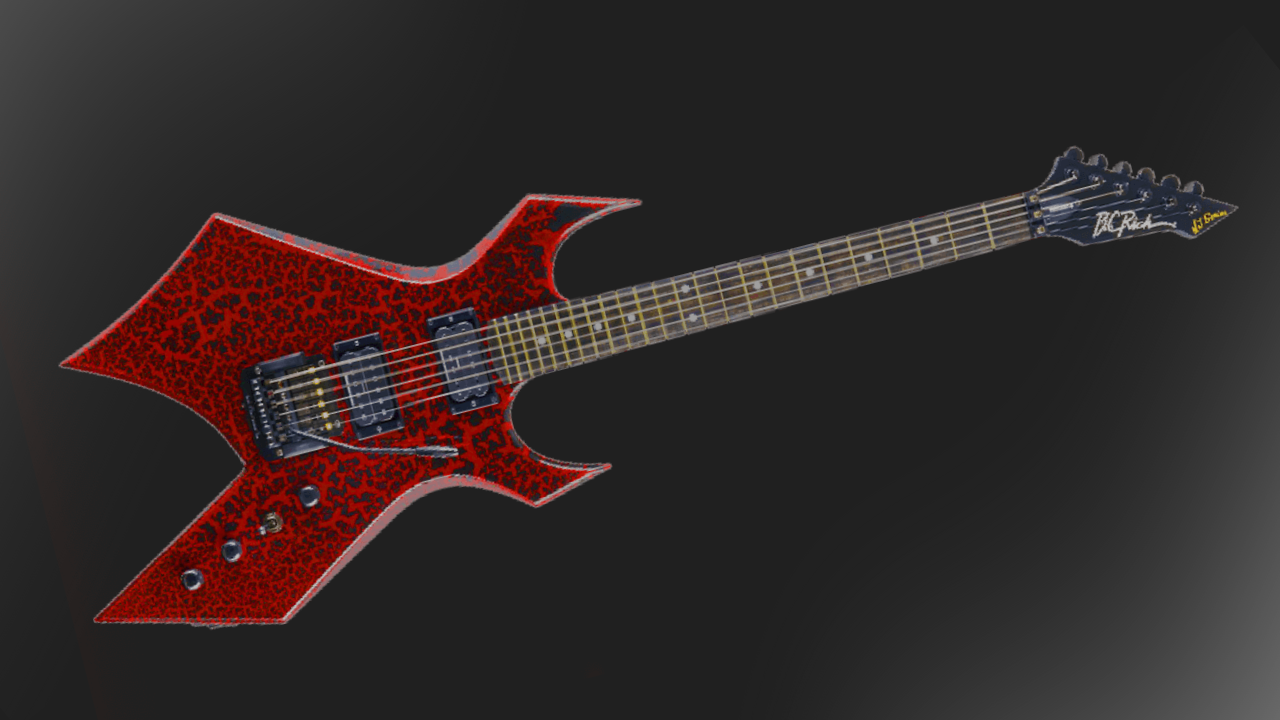
This is the Stranger Things guitar. It’s Eddie’s version of the NJ Warlock from B.C. Rich, and it comes in “Relic Crackle” (shown above) and “Liquid Black.” Needless to say, if this thing had blood, there would be heavy metal coursing through it.
The guitar features an alder body, maple neck, and ebony fretboard. These medium-to-bright sounding woods, combined with dual DiMarzio D Activator humbucker pickups make this guitar extremely qualified to handle high-gain crunch. And, in true metal fashion, this guitar features a locking tremolo bridge with an accompanying Floyd Rose R3 locking nut. So, get ready to take some downright terrifying tremolo dives all the way to the Upside Down.
Other Notable Players & More
Not inspired by Eddie’s performance? There are some other notable players of the B.C. Rich Warlock! Kerry King (Slayer), Chris Poland (Megadeth), Paul Stanley (Kiss), Robb Flynn (Machine Head), and Nikki Sixx (Mötley Crüe) have all favorited this axe at some point in their careers. Another fact about the Warlock is that it was designed in 1969 by the company’s founder, Bernardo Chavez Rico. Interested in learning more, or grabbing one of these limited edition guitar for yourself? Check out the official listing on B.C. Rich’s website!
JamPlay has over 450 guitar courses from 120+ instructors, and online guitar lessons tailored to every skill level, music genre, and playing style. Click here to learn more.
Share this
Become a JamPlay member for unlimited access to 7000+ guitar lessons and 120+ artists and instructors. View membership plans ›
Related Posts
August 30, 2022
Fretboard Woods: Which Type is Best?
Fretboard Woods: Which Type is Best?
If you’re reading this, you probably own a guitar or two. Go pick up your favorite one, and make an observation: what does the fretboard look like? When you play the guitar, how does the fretboard feel? Maybe these are things you’ve never considered before, or have only just begun to wonder about. Not all guitars are created equally. They are ubiquitously made from different combinations of what we call, “tonewoods,” which are woods that resonate well enough to project vibrations made by the strings on your guitar. And when it comes to wood used for fretboards, there are three types that most commonly used.
Ebony, Rosewood, and Maple woods comprise the bulk of materials used to create guitar fretboards. But why these three? Which type is the best? In this article, we’re going to overview these tonewoods and why they are top picks for luthiers!
One very important thing to keep in mind is that there is not one “best” type of wood. There are only types of wood that are best for you and your style of playing or desired aesthetic. In fact, whether or not different woods affect the tone of an electric guitar is a hotly debated topic. A majority of luthiers would agree, however, that the materials they use do impact the resonance, sustain, feel, and tone of a guitar. Let’s take a look at the three primary types of wood used in fretboards. Maybe one of them “resonates” (pun intended) with you!

1. Ebony
Ebony wood has been used for making fretboards since the 1400s, and was considered a superior choice until the last hundred or so years. It is a relatively firm tonewood that is favored for its strength and slick feel. If you are looking for a fretboard that will help you sustain notes better, this is a great pick for you. Ebony fretboard wood also is said to add a sharper, brighter tone to your strings.
Aesthetically, ebony is the darkest wood that you can typically add to your guitar. Brands that are well known for featuring ebony fretboards on their guitars include Gibson, Epiphone, Ibanez, and Jackson. In the picture to the left, you can see how this type of fretboard pairs with a black Gibson Les Paul.

2. Rosewood
Softer than Ebony in both density and appearance, Rosewood has been a top pick amongst luthiers for the last couple hundred years. Because of its porous composition, it is commonly believed that this lends to a softer feeling when fretting notes, as opposed to Ebony’s rigidity. But, this is also the reason that many guitar players will claim that rosewood produces less “bright” of a tone. For fingerstyle guitar players, this might be less desirable, as their plucked notes may not carry enough treble to cut through a mix. For beginner players, though, this might be an ideal fingerboard on which to learn.
As mentioned before, Rosewood is lighter in appearance than Ebony. They are also a very common choice amongst most guitar brands. You would be hard-pressed to find a guitar brand that doesn’t use rosewood on at least a model or two. Some companies are paring back on production of rosewood guitar parts, however, because popular species of Dalbergia (Rosewood) tree are becoming overexploited.
 3. Maple
3. Maple
Maple is the most recent addition to the top three fretboard woods. Its rise in popularity can largely be attributed to Fender. Many of the original Telecasters and Stratocasters feature a “bolt on” neck that is one, solid piece of maple with the frets integrated straight into the neck. To this day, you can still get your hands on a Fender guitar with either a Maple or Rosewood fretboard. Gibson typically does not include Maple fretboards on their guitars. However, the Gibson SG pictured here is part of their limited “Raw Power” series.
Unlike Rosewood, Maple is a harder wood that feels more firm under the fingers. And, similarly to Ebony, it produces a brighter tone and is good for sustaining notes. Unlike Ebony, however, Maple is much hardier. Ebony is known to warp in warmer or humid environments, whereas Maple will hold its shape better. Aesthetically, this type of wood is the lightest in color of these three types of fretboard wood. For some players, these qualities are desirable. For others, these are reasons to avoid Maple fretboards. Remember, it’s all about your personal preference, not about an objective “best” type!
Excited to look at some new guitars? Find all kinds of great guitar gear deals over at Sweetwater.com.
JamPlay has over 450 guitar courses from 120+ instructors, LIVE daily instruction, and online guitar lessons tailored to every skill level, music genre, and playing style. Click here to learn more.
Share this
Become a JamPlay member for unlimited access to 7000+ guitar lessons and 120+ artists and instructors. View membership plans ›
Related Posts
Nirvana Song Lesson Playlist
Grunge and Alternative Rock music simply wouldn’t be the same without the influence of the Washington-originating band, Nirvana. Formed in 1987, Nirvana consisted of singer/guitarist Kurt Cobain, dummer Dave Grohl, and bassist Krist Novoselic. The band released three studio albums between 1989 and 1993, the most notable of them being Nevermind, which peaked at No. 1 in ten countries. Nirvana is, to say the least, one of the biggest influences on modern alternative rock. And thus, Nirvana’s hits are some of most popular songs to cover on guitar.
In this blog, we’ve highlighted the in-depth Nirvana song lessons JamPlay has to offer! Let’s learn some alternative rock hits on guitar!
“About A Girl” – Nirvana Song Lesson
In JamPlay’s “About A Girl” song lesson, educator, Matt Brown shows you how to play all of the chords, rhythm, solo, and complete song form. Here is a sample from the lesson where Matt demonstrates how the whole song is performed on one guitar. For the full breakdown, check out Matt’s full Nirvana song lesson on JamPlay!
“Come As You Are” – Nirvana Song Lesson
In this overview, Allen Van Wert provides a little background for Nirvana’s 1991 hit, “Come As You Are” from their album, Nevermind. The full song lesson features deep dives into the lead riffs throughout the song, chord progressions, and the song’s solo. Check it out on JamPlay!
“Lithium” – Nirvana Song Lesson
As with our “Come As You Are” song lesson, Allen Van Wert gives us an overview of Nirvana’s hit, “Lithium.” The whole song lesson, however, features full lessons on how to play the song’s main riffs and chords. Allen also goes in-depth on an analysis of this alternative rock hit. Check out the complete lesson on JamPlay!
For more Song Lessons, check out JamPlay.com! JamPlay has over 450 guitar courses from 120+ instructors, and online guitar lessons tailored to every skill level, music genre, and playing style. Click here to learn more.
Share this
Become a JamPlay member for unlimited access to 7000+ guitar lessons and 120+ artists and instructors. View membership plans ›
Related Posts
August 23, 2022





